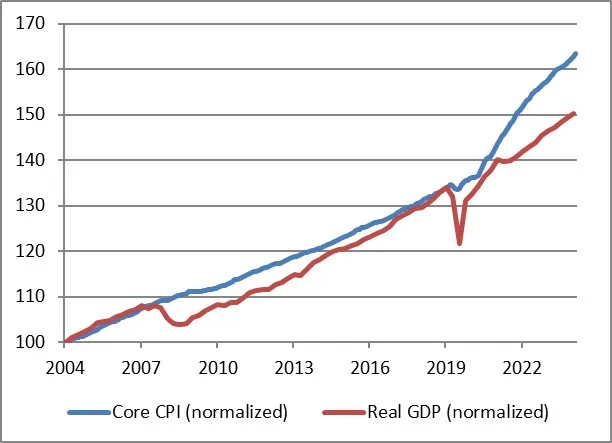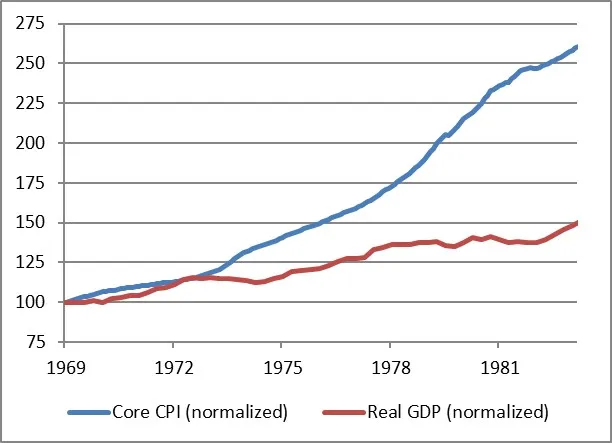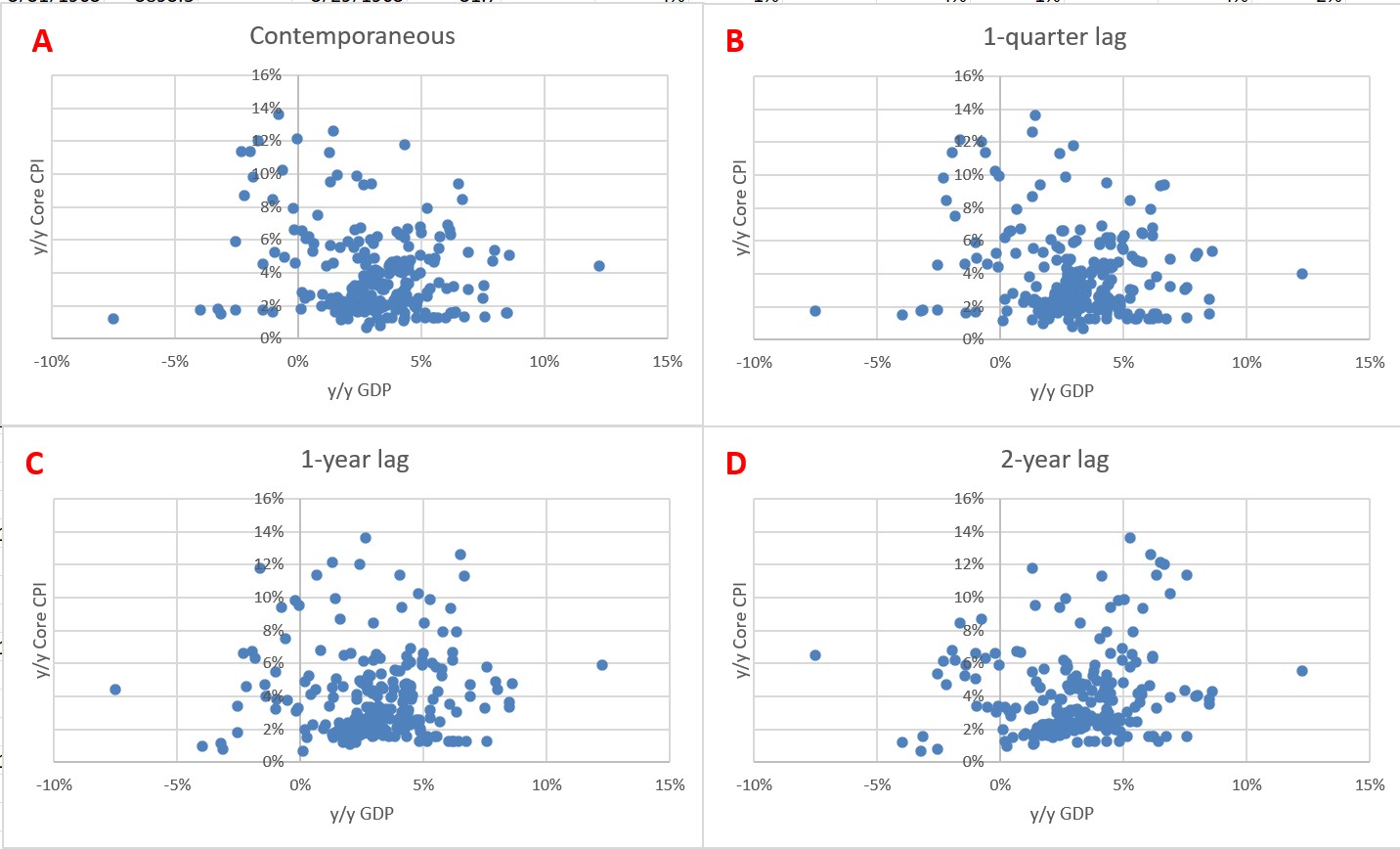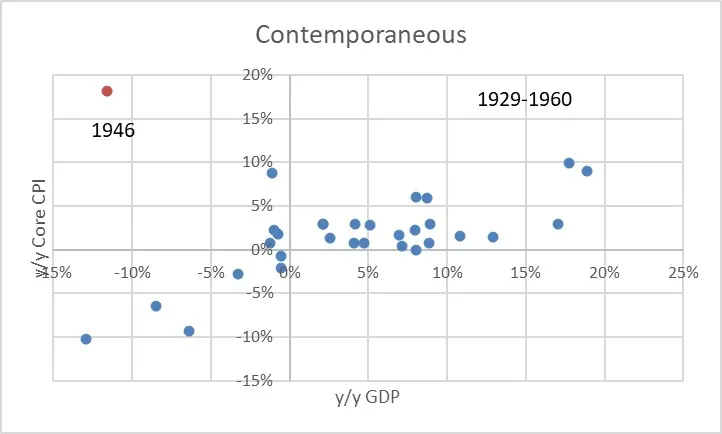I am constantly amazed at certain articles of faith among the economics community. In my line of expertise, one of the most amazing to me is the absolute conviction with which the economics community believes that if the economy grows too fast, inflation will result and if it grows too slowly, disinflation or deflation will result. That this conviction is so strongly held is especially incredible, since there is essentially no evidence for that belief.
Theory says it is so. Growing too fast puts too much pressure on land, labor, and capital, which causes their prices to rise and therefore the price of the output. I mean, obviously. Except that it doesn’t seem to have ever happened that way, at least for a long, long time.
Heck, let’s just take recent experience. In the last twenty years, we have had two global economic crises. The upheaval in 2008 was the largest since at least the Great Depression.
The economic contraction in 2020 made the Global Financial Crisis look like a piker. So obviously, if we look at inflation it must have massively slowed down in those events, right?
Hmmm. Now, I’ve showed the Core CPI price level against GDP. If you squint, you can see a small deceleration in core CPI in 2010: it actually reached only +0.6% y/y at one point. We never even reached deflation, despite the fact that the GFC was triggered by housing and housing is by far the largest component of CPI.
I don’t need to say anything about the COVID period because it is so recent. Core inflation vaulted higher, and continued to do so long after economic output had been fully restored to its prior level.
The other wonderful counterexample I like to show is the 1970s.

Notice there are several flat points here, where GDP was steady-to-lower and the price level kept on truckin’ (that’s a 1970s reference, kids). Notice that since I’m using core CPI, you can’t even say ‘well, the OPEC embargo caused energy prices to spike and that also slowed the economy.’
Yes, it did, but shouldn’t that slowing of the economy have taken pressure off of other non-energy prices? Well, it didn’t. Inflation was robust during the 1970s, despite growth that lurched forward and back in fits and starts.
Those are fun, visual aids but sometimes our eyes can deceive us and hide or exaggerate a relationship that is statistically present (or not). So here I did the economist thing and ran scatterplots at different lags. Each of these shows the y/y change in GDP on the x-axis (quarterly observations, since 1960 until 2024), and y/y changes in Core CPI on the y-axis.
- Chart A shows the y/y changes contemporaneously (1965Q1 vs 1965Q1, e.g.).
- Chart B lags the inflation one quarter, so we see if this year’s growth affected this year’s inflation but lagged a little bit.
- Chart C lags the inflation one year, so we see if this year’s growth affects the coming year’s inflation.
- And Chart D lags the inflation two years, so we see if this past year’s growth affects next year’s inflation.

The correlation coefficients, for your reference: -0.18, -0.13, 0.03, 0.14. That’s thin gruel on which to make a strong argument about growth causing inflation, in my mind.
Now, I’ve run these regressions since 1960 since the core CPI index only goes back to 1957. The same regressions with headline inflation show coefficients of -0.11, -0.05, 0.10, and 0.11. I’m actually surprised they’re not any better, because energy prices should be correlated with growth and flatter the relationship. The OPEC embargo does hurt that relationship, but even if we just run these regressions since 1980 the correlations between growth and headline inflation are just 0.13, 0.19, 0.16, and -0.09.
So where do we get the idea that growth causes inflation?
Well, if I look at GDP growth versus headline inflation, from 1929 until 1960, and I exclude 1946 when industry relaxed from its war footing and war-time price controls were removed, then I can coax a really nice correlation of 0.73.
Indeed, if you look at the correlation between 1929 and 1945, it becomes a whopping 0.88. That’s science, baby – fitting the data to the story! But now I think we get to the heart of the matter because something else momentous happened in 1948 and that was the publication of the first edition of the most-used textbook in history: Paul Samuelson’s Economics. It is no surprise, perhaps, that generations of economists learned this ‘fact’ based on a correlation of 0.88…that has been falling ever since.
Since that time, the correlation between core inflation and growth has been low, and sometimes even negative, over very long periods. If there is any causal relationship, it is completely swamped in exceptions.
Decades-long exceptions. It is time to give up this idea. One unfortunate consequence of that is that the way the Federal Reserve operates is as if there is one dial it can turn and that is ‘the dial that increases growth until inflation gets hot, then decreases growth.’ The problem is that isn’t one dial, it’s two.
In general, I think the Fed should keep its hands off the growth dial, but if it wanted to meddle on rare occasions it would do so by manipulating medium-term interest rates. To control inflation, it needs to moderate the growth of the money supply.
Frankly, in my opinion the FOMC should simply focus on the latter mission and let growth, and markets, take care of themselves. They’re not good at any of these missions anyway.
